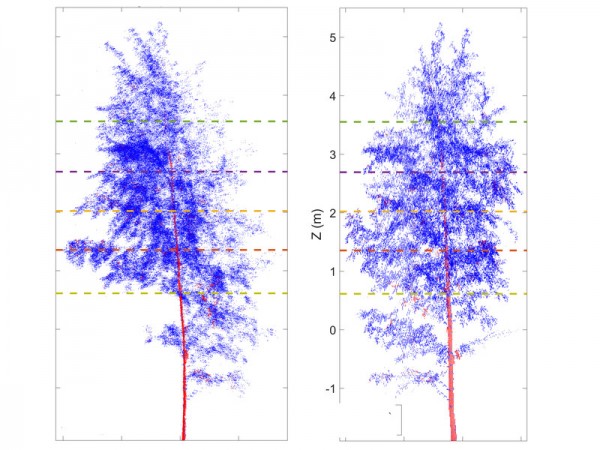Study: Trees Sleep at Night Too
| Ana Verayo | | May 20, 2016 11:24 AM EDT |
(Photo : TU Wien) Trees have their own day-night rhythm too
Can you imagine trees taking a nap in the afternoon or succumbing into deep slumber at night? For the first time ever, scientists have obtained direct observations about the physical changes that occur in trees, that are similar to the act of sleeping in animals and even humans, revealing a day and night rhythm.
Like Us on Facebook
In this new study, an international team of researchers utilized laser scanners to study two trees and examined a cloud composed of millions of different points that are laid out on their surface areas. Using this new data, researchers were able to learn that trees apparently show movement during the night, a natural phenomena that scientists have been observing in smaller plants.
According to Eetu Puttonen of the Finnish Geospatial Research Institute, these results show how the entire tree stoops down during night time that can be observed as a position change among leaves and branches. Although these changes are subtle enough, the team measured 10 centimeters for trees with an average of height of five meters, which reveals a systematic process that have been accurately detected by instruments.
In order to distinguish and determine these crucial effects from weather and location, researchers studied one tree in Finland and another tree in Austria, where weather conditions are milder and there is no wind. During observations, the leaves and branches drooped significantly in a gradual manner, where the maximum position was achieved after around two hours before sunrise. During the morning, the trees returned to their original state of rigidity, in a matter of a few hours.
According to András Zlinszky from Hungary's Centre for Ecological Research, this drooping effect is most likely caused when the tree loses its internal water pressure inside the tree's cells, which is a natural event known as turgor pressure. Zlinsky says that this entails less rigid branches and leaf stems that become more prone to drooping on their own weight. Since turgor pressure is controlled by photosynthesis, this drooping happens when the sun goes down and into the night as photosynthesis stops.
This new study is published in the journal, Frontiers in Plant Science.
Tagstrees, Photosynthesis, trees sleep at night, sleeping trees
©2015 Chinatopix All rights reserved. Do not reproduce without permission
EDITOR'S PICKS
-

Did the Trump administration just announce plans for a trade war with ‘hostile’ China and Russia?
-

US Senate passes Taiwan travel bill slammed by China
-

As Yan Sihong’s family grieves, here are other Chinese students who went missing abroad. Some have never been found
-

Beijing blasts Western critics who ‘smear China’ with the term sharp power
-

China Envoy Seeks to Defuse Tensions With U.S. as a Trade War Brews
-

Singapore's Deputy PM Provides Bitcoin Vote of Confidence Amid China's Blanket Bans
-

China warns investors over risks in overseas virtual currency trading
-

Chinese government most trustworthy: survey
-

Kashima Antlers On Course For Back-To-Back Titles
MOST POPULAR
LATEST NEWS
Zhou Yongkang: China's Former Security Chief Sentenced to Life in Prison

China's former Chief of the Ministry of Public Security, Zhou Yongkang, has been given a life sentence after he was found guilty of abusing his office, bribery and deliberately ... Full Article
TRENDING STORY

China Pork Prices Expected to Stabilize As The Supplies Recover

Elephone P9000 Smartphone is now on Sale on Amazon India

There's a Big Chance Cliffhangers Won't Still Be Resolved When Grey's Anatomy Season 13 Returns

Supreme Court Ruled on Samsung vs Apple Dispute for Patent Infringement

Microsoft Surface Pro 5 Rumors and Release Date: What is the Latest?










